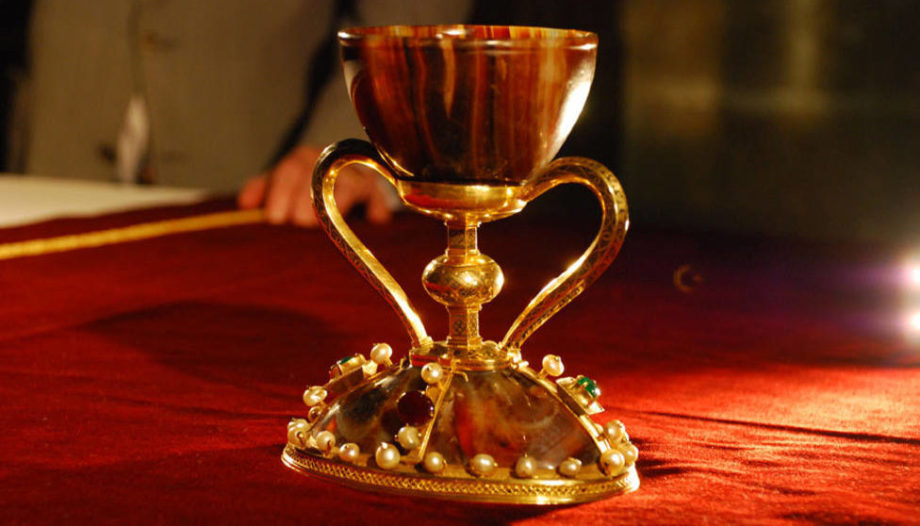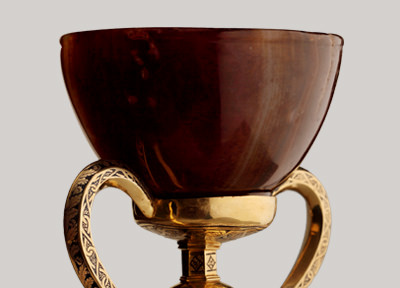The Holy Grail, o holy ChaliceThe cup, of which so much has been written and spoken, is the cup in which Jesus Christ drank with his disciples at the Last Supper, and for this reason it is considered a unique relic. Thus, it was used to institute the sacrament of the sacrament of the Eucharist.
Various legends refer to her, and on some occasions she is attributed with curative properties and in others the power to raise the dead o feeding thousands of soldiers. The legends show the Holy Grail in the form of a cup or a fountain.
For approximately ten centuries, these legends considered that the Knights Templar guarded the Holy Grail, although at no time was it detailed exactly what this relic consisted of.
There are those who relate the Holy Grail and the Joseph of ArimatheaThe authors of the book of Jesus' resurrection maintain that Jesus, already resurrected, would appear to Joseph to give it to him and order him to take it to the island of Britannia. Authors maintain that Joseph would use the chalice to collect the blood and water emanating from the wound opened by the spear of the centurion in the side of Christ and that, later, in Britannia, he established a dynasty of guardians to keep him safe and hidden.
It should be noted that Holy Scripture does not mention the Holy Grail. The first reference we have is from the 12th century.
Origin of the legend of the Holy Grail
The search for the Holy Grail is a theme that is related to the story of King Arthur, combining Christian tradition with ancient Celtic myths referring to a divine cauldron. In addition, there are other legends about the Holy Chalice that are related to those concerning the various ancient cups that are considered to be the authentic relic.
It was first mentioned in history at the beginning of the 12th century by the French author Chrétien de Troyes in its narration Percevalalso called Le Conte du Graal (the Grail story).
In the play, King Arthur's father - known as the Fisher King - was ill. As the country was considered weak because of their leader's illness, several knights went to the king's castle to try to cure him, but only one of them could be the one chosen to bring about the cure.
Perceval
The chosen one was Perceval, and the king offered him a banquet, in which a mysterious procession of a maiden carrying the Holy Grail took place. As he had been advised not to speak too much, Perceval, although amazed by the procession, decided to remain silent, and after the banquet he retired to rest, as did the king.
When Perceval woke up, he realized that the whole castle was deserted. He marched, and going into the forest he met a maiden to whom he told what had happened. She told him that if he had asked the meaning of the procession he would have restored the king to health, since the cup he had seen was the holy Chalice, and it was the king who guarded it. Upon learning all this, Perceval promised to find the Holy Grail and close the search.
The work of Chrétien de Troyes represented the beginning of the legend, but it was other authors who developed this version, as it became known to medieval Europe, spiritualizing it and emphasizing that it was the cup of the Last Supper; the same one that, according to different sources, Joseph of Arimathea later used to collect the blood from the wounds during the crucifixion of Christ.
Several Holy Grails?
As we were saying, we have several versions of Grail saints that are considered authentic relics. We would highlight the following:
The Holy Chalice of the Valencia Cathedral, Spain
Considered as the chalice brought from Rome to Spain thanks to St. Lawrence the Martyr in the third century. Prior to its deposit in Valencia it was in various places in Aragon, such as the monastery of San Pedro de Siresa, the cathedral of Jaca or the monastery of San Juan de la Peña. After a short stay in Barcelona it arrived in Valencia.
Composed of an agate cup of 7 cm high and 9.5 cm in diameter, with a foot with handles added later. Dated by the specialists in the first century, and considered as an authentic Hebrew cup when observing the measures used at the time for this type of utensil. Made on stone catalogued as sardiusIt is representative of the tribe of Judah, the tribe to which Our Lord belonged. At the bottom, in addition, there is an inscription in Hebrew that alludes to Jesus.
The pontiffs who have visited Valencia - St. John Paul II and Pope Emeritus Benedict XVI - used it in the mass Eucharist they celebrated during their visits. This gesture about the tradition that concerns us -that this is indeed the Holy Chalice- and the fact that it has been declared a holy Jubilee year in Valencia in 2015, reinforce its authenticity.
The Chalice of Doña Urraca
It is a chalice composed of two onyx cups of Roman origin that Doña Urraca - Spanish queen of the 11th century - had enriched, claiming that it was the Holy Grail. She received it from her father, Ferdinand I the Great, who in turn took it from the Muslim caliphs who donated it to her.
It must be said that this thesis lacks academic value, and certain errors are acknowledged to the detriment of its veracity.
The Holy Grail O'Cebreiro
In the middle of the road to Santiago we have a chalice guarded in the monastery of Santa Maria de O'Cebreiro since the mid-twelfth century, which is believed to be the Holy Grail.
Tradition holds that a Eucharistic miracle took place in such a cup, consisting in the conversion of the wafer and the wine that the celebrant would use in the Eucharist into sensitive flesh and blood, which stained the corporals. Later, in the 15th century, the Catholic Monarchs, during a visit to the monastery, would donate the lanterns that would guard the relic, attributing this gesture greater certainty about the authenticity of the holy Chalice.
However, there are those who maintain that this cup is not the Holy Grail, since its assimilation was due to a simple linguistic confusion, given that the O'Cebreiro hostelry was dedicated to Saint Geraldo de Aurillac, pronounced "Guiral", which would give rise to the confusion of having it for the Holy "Grail".
Hawkstone Park Cup
This version of the Holy Grail refers to the cup that was taken to England after the sack of Rome by the Visigoths. Of small dimensions - barely 6 cm - made of semi-precious stone, it is very possibly dated to Roman times.
It was located in the 13th century in the hands of a British family, hidden in a cave in Hawkstone Park, near Whittington Castle -northwest England- and found at the beginning of the 20th century, when it belonged to Victoria Palmer by inheritance.
Achatschale
It consists of a 4th century bowl from Constantinople or Trier, and has an inscription that reads "XRIST", attributed to Jesus Christ.
What makes one think that it could be the true Holy Grail is the fact that it was part of the imperial relics of the Holy Roman Empire, which also included the spear of Longinus, the Roman soldier who pierced the side of Our Lord once he hung on the Cross just before expiring.
As can be seen, several versions could be the authentic Holy Grail. In any case, the interesting thing is that each one of them serves to increase the piety and devotion to the Eucharist from the place where it is found, since the genuine sense of preserving a relic is to contribute to that devotion or popular piety.









